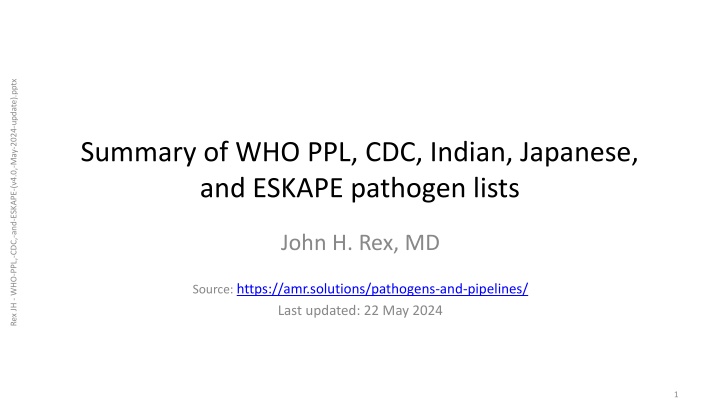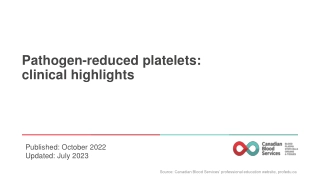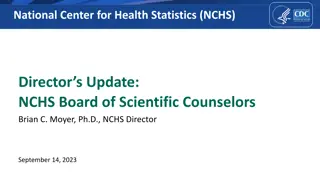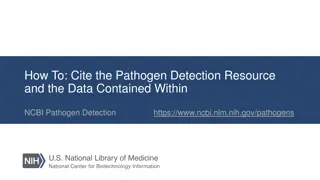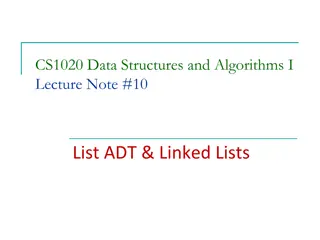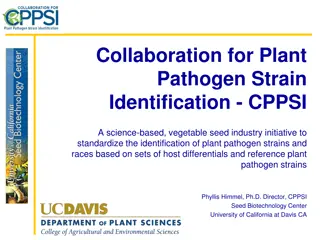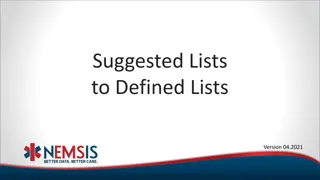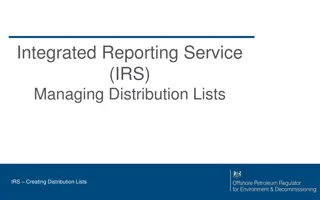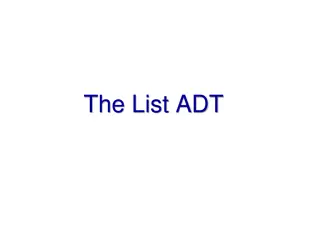Summary of WHO, CDC, Indian, Japanese, and ESKAPE Pathogen Lists - May 2024 Update
This summary provides an overview of the latest pathogen lists from WHO, CDC, India, Japan, and ESKAPE, highlighting critical and urgent priority pathogens, resistant strains, and global research priorities for infectious diseases. The document includes details on bacterial and fungal pathogens, drug resistance patterns, and key focus areas for public health interventions and research.
Download Presentation

Please find below an Image/Link to download the presentation.
The content on the website is provided AS IS for your information and personal use only. It may not be sold, licensed, or shared on other websites without obtaining consent from the author.If you encounter any issues during the download, it is possible that the publisher has removed the file from their server.
You are allowed to download the files provided on this website for personal or commercial use, subject to the condition that they are used lawfully. All files are the property of their respective owners.
The content on the website is provided AS IS for your information and personal use only. It may not be sold, licensed, or shared on other websites without obtaining consent from the author.
E N D
Presentation Transcript
Rex JH - WHO-PPL,-CDC,-and-ESKAPE-(v4.0,-May-2024-update).pptx Summary of WHO PPL, CDC, Indian, Japanese, and ESKAPE pathogen lists John H. Rex, MD Source: https://amr.solutions/pathogens-and-pipelines/ Last updated: 22 May 2024 1
ESKAPE (2008-9) India (2021)1 (mostly bacterial) Priority Pathogen Lists WHO (2024) WHO (2017) Japan (2021) CDC (2019) CDC (2013) Acinetobacter baumannii, carbapenem-R Critical Critical Critical Priority 1 Urgent (carbapenem-R) Serious (MDR) Yes Enterobacterales (Enterobacteriaceae), carbapenem-R Critical Critical Critical Priority 1 Urgent Urgent Yes Enterobacterales (Enterobacteriaceae), 3rd-gen ceph-R (ESBL+) Critical Critical Critical Priority 1 Serious Serious Yes Pseudomonas aeruginosa, carbapenem-R High Critical Critical Priority 1 Serious (MDR) Serious (MDR) Yes Rex JH - WHO-PPL,-CDC,-and-ESKAPE-(v4.0,-May-2024-update).pptx Enterococcus faecium, vancomycin-R High High High Priority 2 Serious (VRE) Serious (VRE) Yes High (R to meth, vanc, dapto, lzd) Serious (MRSA) Concerning (VRSA) Priority 2 (MRSA & VRSA) Staphylococcus aureus High (MRSA) High (MRSA, Vanc-I/R) Serious (MRSA) Yes Salmonellae, (both typhoidal & non-typhoidal) High (FQ-R) High (FQ-R) High (drug-R) Priority 3 (drug-R) Serious (drug-R) Serious (drug-R) Neisseria gonorrhoeae, 3rd-gen ceph-R, fluoroquinolone-R High High Priority 1 Urgent (drug-R) Urgent (drug-R) Shigella spp., fluoroquinolone-R High Medium Medium Priority 3 (FQ-R) Serious (drug-R) Serious Streptococcus pneumoniae Medium (Macrolide-R) Medium (PCN-NS) Medium (PCN-NS) Priority 2 (PCN-NS) Serious (drug-R) Serious (drug-R) Haemophilus influenzae, ampicillin-R Medium Medium Medium Priority 3 Group A Streptococcus Medium (Macrolide-R) Priority 3 Concerning (erythro-R) Concerning (erythro-R) Group B Streptococcus Medium (PCN-R) Priority 3 (clinda-R) Concerning (clinda-R) Concerning (clinda-R) Helicobacter pylori, clarithromycin-R High Priority 3 Campylobacter spp., fluoroquinolone-R High Priority 3 (drug-$)d Serious (drug-R) Serious (drug-R) Staphylococcus, coagulase-neg, Van/Lzd-R Medium Neisseria meningitidis, 3rd-gen ceph-R, fluoroquinolone-R Medium Clostridium difficile Priority 2 Urgent Urgent Critical (Rifampin-R)2 Separate3 Priority 14 M. tuberculosis Serious (drug-R) Serious (drug-R) Priority 1 (C. auris) Priority 2 (Drug-R) Urgent (C. auris) Serious (Drug-resistant) Candida spp. fluconazole-R Serious (Flu-R) 1. The Indian PPL sometimes differs slightly from WHO in terms of patterns of qualifying R. 2. Rifampin-R TB is flagged separately as a Critical Pathogen 3. TB is flagged in a standalone section as a global priority for R&D. 4. Non-tuberculous mycobacteria are included at Priority 1 by Japan Aspergillus fumigatus Priority 2 (azole-R) Watch (azole-R) This is the (mostly) bacterial PPL. See next for the antifungal PPL. Mycoplasma genitalium Priority 2 (drug-R) Watch (drug-R) Bordetella pertussis Watch (drug-R) Bacteroides fragilis (MDR) Priority 3 2
Fungal PPL Fungal Priority Pathogen List WHO 2022 CDC (2019) CDC (2013) Cryptococcus neoformans Critical Aspergillus fumigatus Critical Watch (azole-R) Rex JH - WHO-PPL,-CDC,-and-ESKAPE-(v4.0,-May-2024-update).pptx Critical (C. auris) Urgent (C. auris) Serious (Flu-R) Serious (Drug-resistant) Critical (C. albicans) High (C. tropicalis) Candida spp. (and related genera) High (C. parapsilosis) High (Nakaseomyces glabrata; Candida glabrata) Medium (Pichia kudriavzeveii; Candida krusei) Histoplasma spp. High Eumycetoma causative agents High Mucorales High Fusarium spp. High Scedosporium spp. Medium Lomentospora prolificans Medium Coccidioides spp. Medium Cryptococcus gattii Medium Talaromyces marneffei Medium Pneumocystis jirovecii Medium 3 Paracoccidioides spp. Medium
Sources & References WHO 2024 PPL https://www.who.int/publications/i/item/9789240093461 WHO 2022 Fungal PPL https://www.who.int/publications/i/item/9789240060241 India 2021 PPL http://dbtindia.gov.in/sites/default/files/IPPL_final.pdf Japan 2021 PPL (AMED-led) https://id3catalyst.jp/apid/en/list.html https://www.amed.go.jp/program/list/15/01/kansensho_iyaku_houkokusho.html CDC 2019 Threat List Downloaded 11 Feb 2020: https://www.cdc.gov/drugresistance/pdf/threats-report/2019-ar-threats-report-508.pdf WHO 2017 PPL (aka, Priority Bacterial Pathogens List) Downloaded 27 Feb 2017 from http://www.who.int/medicines/publications/WHO-PPL-Short_Summary_25Feb-ET_NM_WHO.pdf See also Tacconelli et al., Lancet ID, Dec 2017: http://www.thelancet.com/journals/laninf/article/PIIS1473-3099(17)30753-3/fulltext CDC 2013 Threat List Downloaded 28 Feb 2017 from https://www.cdc.gov/drugresistance/pdf/ar-threats-2013-508.pdf ESKAPE Rice LB. Federal funding for the study of antimicrobial resistance in nosocomial pathogens: no ESKAPE. J Infect Dis. 2008;197(8):1079-81. Boucher HW et al. Bad Bugs, No Drugs: No ESKAPE! An Update from the Infectious Diseases Society of America. Clinical Infectious Diseases. 2009;48(1):1-12. Rex JH - WHO-PPL,-CDC,-and-ESKAPE-(v4.0,-May-2024-update).pptx 4
Background: First vs. Best 1910 1920 1930 1940 1950 1960 1970 1980 1990 2000 2010 2020 Rex JH - WHO-PPL,-CDC,-and-ESKAPE-(v4.0,-May-2024-update).pptx Arsenicals (2) 1 1 Sulfas (9) 1 1 1 1 1 1 1 1 1 BLs (67) 1 1 1 1 1 1 1 1 1 1 2 2 1 2 7 1 4 5 1 3 3 2 2 3 1 1 1 1 6 1 1 1 1 1 1 1 2 Core messages from this analysis of the 27 discrete classes discovered to date: Of these, 13 classes have one drug whereas one class (beta-lactams) has 67 drugs. When more than one in a class, the span from first to next (2nd in class) ranges from a few years to decades. Time from first to last is usually decades. Peptides (1) 1 Aminoglycosides (10) 1 1 1 1 1 1 1 1 1 1 Tetracyclines (10) 1 1 1 1 1 1 1 1 2 Amphenicols (2) 1 1 Macrolides (9) 1 1 1 3 1 1 1 Glycopeptides (5) 1 1 1 1 1 Polymyxins (1) 1 Streptogramins (3) 1 1 1 Nitroimidazoles (2) 1 1 DHFRs (2) 1 1 Fusidic acids (1) 1 Fusafungines (1) 1 Q-FQs (13) 1 1 1 1 3 2 3 1 Rifamycins (2) 1 1 Lincosamides (1) 1 Fosfomycins (1) 1 Monobactams (1) 1 Pseudomonic acids (1) 1 Ansamycins (1) 1 Oxazolidinones (2) 1 1 Lipopeptides (1) 1 Summary Singletons and multi-drug classes occur at similar rates First-in-class is not necessarily best Macrocycles (1) 1 Diarylquinolines (1) 1 Pleuromutilins (1) 1 Decoding of the more obscure names Macrocycle = Fidaxomycin; Ansamycin = Rifaximin; Pseudomonic acid = Mupirocin (topical); Fusafungin = fusafungine; Peptides = Gramicidin S Data sources: https://en.wikipedia.org/wiki/Timeline_of_antibiotics; Outterson and Rex, Translational Research 2020 (https://doi.org/10.1016/j.trsl.2020.02.006) 5
Just the timeline graphic Rex JH - WHO-PPL,-CDC,-and-ESKAPE-(v4.0,-May-2024-update).pptx 1910 1920 1930 1940 1950 1960 1970 1980 1990 2000 2010 2020 Arsenicals (2) 1 1 Sulfas (9) 1 1 1 1 1 1 1 1 1 BLs (67) 1 1 1 1 1 1 1 1 1 1 2 2 1 2 7 1 4 5 1 3 3 2 2 3 1 1 1 1 6 1 1 1 1 1 1 1 2 Peptides (1) 1 Aminoglycosides (10) 1 1 1 1 1 1 1 1 1 1 Tetracyclines (10) 1 1 1 1 1 1 1 1 2 Amphenicols (2) 1 1 Macrolides (9) 1 1 1 3 1 1 1 Glycopeptides (5) 1 1 1 1 1 Polymyxins (1) 1 Streptogramins (3) 1 1 1 Nitroimidazoles (2) 1 1 DHFRs (2) 1 1 Fusidic acids (1) 1 Fusafungines (1) 1 Q-FQs (13) 1 1 1 1 3 2 3 1 Rifamycins (2) 1 1 Lincosamides (1) 1 Fosfomycins (1) 1 Monobactams (1) 1 Pseudomonic acids (1) 1 Ansamycins (1) 1 Oxazolidinones (2) 1 1 Lipopeptides (1) 1 Macrocycles (1) 1 Diarylquinolines (1) 1 Pleuromutilins (1) 1 6
